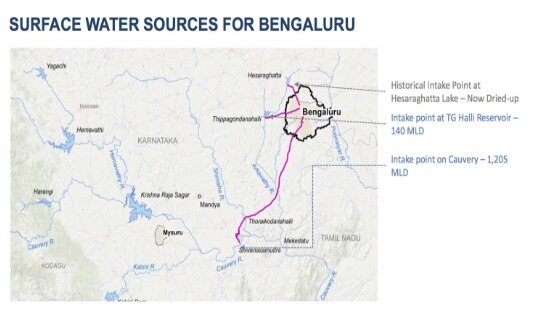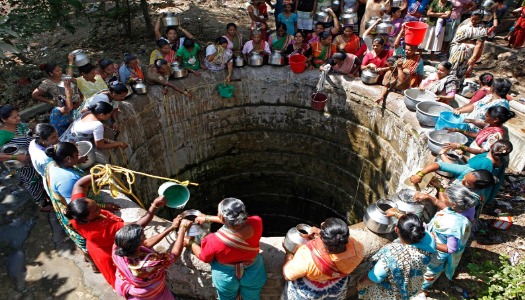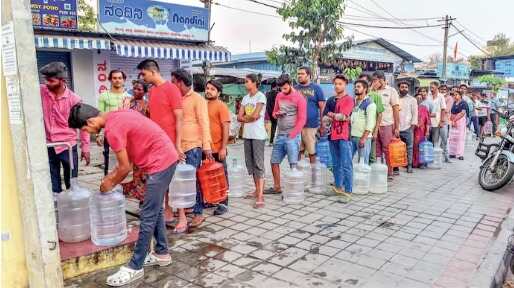Bengaluru, a bustling city in India, is grappling with a severe water crisis. Every day, the city requires a staggering 26,300 million liters of water to meet everyone’s needs. However, it’s only receiving a small fraction of that amount. Bengaluru faces a shortfall of 500 million liters of water daily, akin to attempting to fill a large swimming pool with just a tiny cup of water.
Why is There a Crisis?
Bengaluru is currently facing a significant water crisis, particularly as the summer months approach. This crisis stems from several key factors:
- Insufficient Rainfall and Depleted Reservoirs: In recent years, the city has experienced scanty rainfall, significantly impacting the Cauvery River, a primary water source. This has led to reduced water availability for drinking and agriculture, with critical reservoirs like Harangi, Hemavathi, and Kabini experiencing substantial depletion due to the water crisis.
- Groundwater Depletion: Bengaluru’s rapid urbanization has resulted in reduced natural land cover, such as forests, which historically absorbed rainwater. This has impeded groundwater recharge, exacerbating the water crisis as less water infiltrates into the ground. Additionally, the excessive reliance on borewells has further worsened the situation, with water levels diminishing due to inadequate rainfall and excessive pumping.
- Inadequate Infrastructure: The city’s water supply and sewage systems have struggled to keep pace with its rapid expansion, exacerbating the water crisis. This has made it challenging to distribute water efficiently to meet the demands of the growing population. Although improvement plans are underway, operationalizing them remains a challenge amid the ongoing water crisis.
- Impact of Climate Change: Unusual weather patterns, including reduced rainfall and prolonged droughts attributed to climate change, have significantly contributed to the water scarcity in Bengaluru. Climate phenomena such as El Niño have disrupted normal weather conditions, further decreasing water levels in the city’s reservoirs and lakes, and deepening the water crisis.
- Water Pollution Concerns: Pollution from industrial waste, untreated sewage, and improper waste disposal has severely contaminated many water sources in Bengaluru. Shockingly, approximately 85% of the city’s lakes and rivers are now polluted, rendering the water undrinkable and compounding the existing water crisis.
- Legal and Political Problems: Arguments over who gets how much water, especially from the Cauvery River, make it hard to fix the problem. The central and state governments also need help to agree on how to spend money to help with the drought.
Addressing this multifaceted water crisis demands urgent and coordinated action, including sustainable water management practices, infrastructure upgrades, pollution control measures, and policy interventions to mitigate the impacts of climate change. Additionally, resolving legal and political disputes over water allocation, particularly concerning the Cauvery River, is crucial to effectively tackling the water crisis and ensuring sustainable water access for Bengaluru’s residents. economy
What’s the Impact?
- Acute water shortage – Bengaluru is facing acute water shortages, with many areas receiving water supply for only a few hours every few days. This forces residents to rely on expensive private water tankers, creating a significant financial strain on households, especially those already struggling to make ends meet.
- Health Risk – In addition, contaminated water sources and inadequate sanitation infrastructure pose serious health risks to residents, leading to rampant waterborne diseases such as cholera, typhoid, and gastroenteritis. This results in widespread illness and suffering among the population, emphasising the urgent need to address the water crisis to protect public health.
- Economic challenges – The water crisis in Bengaluru has profound economic implications, affecting various sectors including industries, agriculture, and tourism. Businesses struggle to operate efficiently amid water shortages, while farmers face declining crop yields due to inadequate irrigation facilities, exacerbating economic challenges associated with the water crisis.
- Social Inequalities – Furthermore, marginalised communities bear the brunt of the water crisis, exacerbating existing social inequalities. Lack of access to clean water and sanitation perpetuates cycles of poverty and deprivation, widening the gap between different segments of society and underscoring the need for comprehensive measures to address the water crisis and promote social equity.
People Taking Action
Despite the water crisis challenges, people in Bengaluru are not sitting idly by. They’re coming up with clever ways to save water and spreading the word about why it’s so important. From setting up rainwater collection systems to teaching others about water conservation, everyone is doing their bit to help.

How is Industrialization Affecting Groundwater?
Groundwater, essential for drinking water, irrigation, and various uses, is stored beneath the earth’s surface in spaces between soil particles, cracks, and crevices in rocks. It acts like a crucial underground reservoir that we tap into. However, rapid industrialization in Bengaluru is exacerbating the water crisis by putting a strain on groundwater resources. Industries, requiring substantial water for their operations, contribute to groundwater depletion as some of this water seeps into the ground. Moreover, pollutants from industries can contaminate groundwater, rendering it unsafe for drinking and other purposes.
How is the government trying to improve the situation?
- To deal with the water shortage, the state government plans to use milk tankers from the Karnataka Milk Federation (KMF) to deliver water to Bengaluru. They will also take control of private borewells in and around the city.
- Recognizing the urgency of addressing the water crisis and reducing water losses, the Bengaluru Water Supply and Sewerage Board (BWSSB) initiated a comprehensive project in 2011. Supported financially by the Japan International Cooperation Agency (JICA), BWSSB launched a mission to minimise Unaccounted For Water (UFW) losses to under 16%.
- The availability of Cauvery water has played a critical role in sustaining Bengaluru’s water supply amid the ongoing water crisis. However, it’s crucial to acknowledge the broader implications of urban hydrology on groundwater dynamics. The influx of Cauvery water, coupled with natural recharge processes facilitated by pipeline leakages, contributes to maintaining a healthy groundwater table in the city centre.
Major Steps to Save Water Resources

Conservation: We can all do our part to conserve water by using it wisely at home, fixing leaks, and adopting water-saving technologies.
Rainwater Harvesting: Harvesting rainwater is a great way to collect and store rainwater for later use. This water can be used for watering plants, washing cars, and even for drinking if properly treated.
Improving Water Management: The government needs to improve water management practices, including better maintenance of sewage treatment plants, reducing water wastage, and implementing policies to protect groundwater.
Promoting Water Recycling: We can recycle water from sources like sewage treatment plants for non-potable uses like irrigation and industrial processes. This reduces the strain on freshwater sources and helps conserve water.
Public Awareness: Educating the public about the importance of water conservation and sustainable water use is crucial. By raising awareness and promoting behaviour change, we can all contribute to saving water for future generations.
Conclusion:
The water crisis in Bangalore is a complex and pressing issue that requires immediate attention and concerted action. By implementing the proposed solutions and involving all stakeholders in the process, we can work towards ensuring a sustainable water future for the city. We must act now to safeguard this precious resource for future generations and ensure the well-being of all residents of Bangalore. By leveraging partnerships and embracing innovative solutions, the city can mitigate risks associated with water scarcity and build resilience against future challenges.
-Abhinash Pritiraj & Sneha Raj
MUST READ: BEYOND DISPOSABLE: UNVEILING THE DANGERS OF SINGLE-USE PLASTICS





